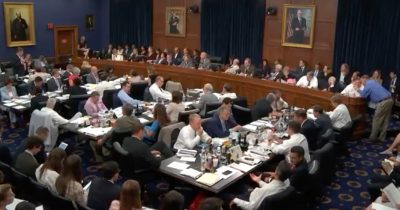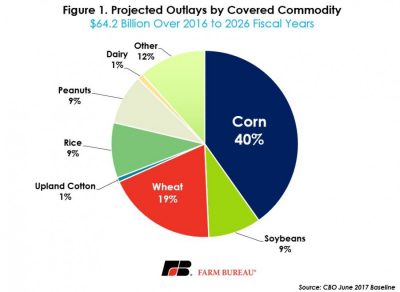As 2026 ushers in a fresh start, agricultural economists say the U.S. farm economy has stopped sliding, but it’s far from fully healed.The December Ag Economists’ Monthly Monitor shows month-to-month…
Spending and Budgetary Issues- Agriculture, Farm Bill
Today’s update looks at recent spending and budgetary issues impacting agriculture and the Farm Bill. The House Appropriations Committee this week passed the fiscal year 2018 appropriations bill for USDA. Meanwhile, recent reporting from Politico indicated that House Agriculture Committee Chairman Mike Conaway (R., Tex.) reached a “handshake agreement” with House Budget Chairwoman Diane Black (R., Tenn.) on potential cuts to ag and nutrition programs. And, the Congressional Budget Office recently released its latest baseline for farm programs.
House Agriculture Appropriations Bill Passes Full Committee
Recall that late last month, the House Appropriations Agriculture Subcommittee passed the fiscal year 2018 Agriculture Appropriations bill on a voice vote.
Back in May, Secretary of Agriculture Sonny Perdue appeared before the Appropriations Ag Subcommittee to discuss the administration’s budget outline; lawmakers expressed specific concerns about executive branch funding proposals for crop insurance and the SNAP program (food stamps).
The Agriculture Appropriations bill that passed the Subcommittee did not include many of the provisions in the Trump administration’s budget outline, including proposed crop insurance changes. A summary of some of the key provisions in the Subcommittee bill can be found here.
On Wednesday, the full House Appropriations Committee approved the fiscal year 2018 Agriculture Appropriations bill on a voice vote.
The FY18 Agriculture Appropriations Bill was just approved on a voice vote:
— House Appropriations (@HouseAppropsGOP) July 12, 2017
Politico’s Morning Agriculture update reported yesterday that, “The House Appropriations Committee on Wednesday easily advanced a $20 billion agriculture discretionary spending bill for fiscal 2018, after adopting a handful of amendments that touch on issues including farm loans and housing for migrant farmworkers. Over all, the measure would provide $876 million less funding than fiscal 2017 enacted levels for the USDA, FDA and Commodity Futures Trading Commission.
It would make cuts across the majority of programs including farm loans, rural development, agricultural research, and efforts to control pests and diseases. Appropriators, however, rejected President Donald Trump’s request for billions more in cuts.
From a technical standpoint, Bloomberg BNA writer Renee Hickman noted after Wednesday’s Appropriations Committee action that, “Now it is ready for floor action by the full House.”

However, DTN Political Correspondent Jerry Hagstrom explained yesterday that, “It’s unclear how Congress will handle agency appropriations, though, because the House Budget Committee has not completed its work in defining the parameters of the full federal budget for fiscal year 2018.”
Federal Budget Issues- Farm Bill Spending
In more detail on the larger federal budget issue and Farm Bill spending, Politico writers Catherine Boudreau and Helena Bottemiller Evich reported earlier this week that, “The fate of billions of dollars for farmers and food stamps may have already been sealed, and perhaps saved, last month.
“That was when House Agriculture Chairman Mike Conaway and Budget Chairwoman Diane Black sat down one last time to hammer out a deal behind closed doors.
“The lawmakers didn’t disclose specifics about their handshake agreement reached that hot Thursday morning, nor was a total spending figure made public. But House aides and agriculture lobbyists say Conaway was able to stave off billions in proposed spending cuts to agriculture and nutrition programs.”
The Politico article indicated that, “‘As far as Ag Committee and Budget, we’re done,’ Conaway declared to reporters on the afternoon of June 29. ‘It’s a number that I agreed to.’
Sources with knowledge of the discussions say that the agriculture committee was initially facing around $70 billion in proposed cuts over the next decade, but Conaway’s intervention kept the pullback to around $10 billion.
“That came after Black lowered her original goal for total mandatory spending cuts by roughly $300 billion, and Conaway persistently made the case that slashing programs under his watch would imperil the 2018 farm bill and, by extension, farmers, rural constituents and low-income Americans struggling to make ends meet.”
Meanwhile, Catherine Boudreau noted yesterday at Politico that, “The chances of the House passing a budget resolution are slowly shrinking, as factions of the GOP continue to make demands, reports POLITICO’s Sarah Ferris, Jennifer Scholtes and Luis Sanchez. House Republicans may have agreed to Budget Chairman Diane Black’s topline numbers — $511 billion for domestic spending and $621.5 billion for defense — but the House Freedom Caucus and the centrist Tuesday Group still have concerns.”
Congressional Budget Office Projections
An update this week at the National Sustainable Agriculture Coalition blog explained that, “Every year, usually in March but this year delayed until late June, the Congressional Budget Office (CBO) publishes its ten-year projection (baseline) for government spending – including farm bill spending. CBO, Congress’ official scorekeeper, typically publishes a preliminary projection in January, an official projection in March (June this year), and then a mid-year projection update in August. CBO’s March (June this year) projection is generally the one that rules budget scoring for all bills considered by Congress during the year.
It is not yet clear whether the most recently issued CBO baseline will be the one used for 2018 Farm Bill purposes, or if it will be the one issued next March. In either event, however, the current baseline can provide us with important insights into the coming farm bill debate.
And, earlier this month, John Newton, the Director of Market Intelligence at Farm Bureau noted in an update (“Farm Bill Math Updated in New Congressional Budget Office Baseline”) that, “CBO’s June 2017 Baseline for Farm Programs was released on June 29, 2017. These projections identify expected outlays for farm bill program spending, assuming existing programs continue without changes, and will serve as an indicator of program spending available to Congress as crafting of the 2018 farm bill kicks into higher gear.”
Dr. Newton stated that, “Farm bill math creates a few possible scenarios. Depending on negotiations between the budget and agricultural committees [note, e.g., see previous section of today’s update] the next farm bill could be required to be budget neutral, meaning any increase in spending in one part of the bill would require a decrease in spending elsewhere in the bill, or it could be required to have a net reduction. Given these budget directives, scoring a bill (estimating the additional outlays and potential savings relative to the baseline) is one of the most critical components of farm bill development.
From now through the farm bill’s passage, any change in policy will require an estimate of the budgetary impact. A farm bill written in 2017 would be scored against this baseline, and a bill written in 2018 would be scored against a spring 2018 baseline, or depending on progress in negotiations, could be scored against this June baseline.
Dr. Newton added that, “Many of the provisions of current farm programs move in opposite direction of commodity prices. Consequently, several years of lower prices have resulted in higher commodity support payments. Estimates of total farm program expenditures during the 2016 to 2026 fiscal years are now estimated at $64.2 billion dollars, up $3.5 billion over CBO’s March 2016 projections. Peanuts, cotton and soybeans saw their 10-year baselines decline, while corn, wheat, rice and dairy baselines increased in value.”

The update added that, “This most recent CBO baseline on farm program outlays is an important indicator of the budget outlook going into the next farm bill debate. Underpinning these budget forecasts are important estimates of commodity supply and use. Lower than forecasted commodity prices would be expected to result in higher outlays by the spring 2018 baseline. Similarly, improvements in commodity prices would result in lower projected outlays for farm programs. These market fundamentals will be important to monitor as they will ultimately impact the budget and development of the next farm bill.”





